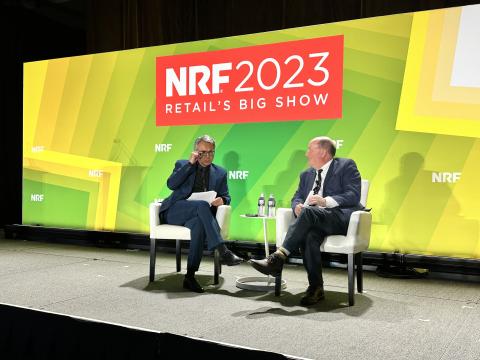Sprouts Farmers Market CEO Details Top Grocery Trends for 2023

The year 2023 seems to be a year of uncertainty for many in the grocery industry, but during NRF's Big Show in New York City, Sprouts Farmers Market CEO Jack Sinclair shared some specific ideas about where the sector is going.
"We're seeing a lot of dynamic change going on," Sinclair said. "The digital commerce space is growing much faster than I think any of us would have expected. The food at home trend has grown much faster than a lot of us would have expected. The role of food as health, and this relationship between nutrition and health, is one of the three big trends. The pandemic sped up the changes that have gone on. But I think they were going to happen anyway, and they're going to continue to happen. I think there's a momentum. The challenge for people running grocery retail businesses like myself is, 'How do we invest, and when do we invest, to get behind those key fundamental changes?' "
[Read more: "NRF’s ‘Big Show’ Offers Inspiration, Innovation"]
Sinclair, in conversation with Sajal Kohli, senior partner at McKinsey and Co., said Sprouts is spending a lot of time thinking about "the best way for us to navigate our way through the challenges that come from this dynamic of growth? How do we do it? How are we all going to invest in it?"
Kohli mentioned the food at home trend has grown at 9% in the past 12 months. Meanwhile, online grocery penetration is settling at 11%, he said, and the number of downloads from grocery apps is at an all-time high.
"Lots of consumers, given the high digital penetration we saw during pandemic, find online grocery pretty convenient," Kohli said. "That's why we're seeing an incredible amount of capital spending on omnichannel digital penetration."
Some grocery players are focusing on meal solutions and e-commerce, while others are diving into expansion of private brands. But for now, Sprouts is prioritizing what Sprouts is known for: a beautifully curated assortment.
"It's very much important for us to have the curation and differentiation that allows us to have that appeal to a customer that you can't buy elsewhere," Sinclair said. "A lot of the investment from the digital world that's moving into the physical world, is based on having an assortment that everyone can access. Our aspiration is to be a great, curated organization so that people can only get what they want at Sprouts."
Sinclair, who has now led Sprouts for nearly four years, explained that curation helps the grocer compete effectively in the current inflationary environment.
"Part of having a curated assortment is that it allows you to manage inflation," he said. "But having said that, consumers are under pressure. ... People are buying a little bit less volume as the prices go up. That trend and how you navigate your way through that is going to be pretty important. I don't see food inflation changing much over the next little while because of the supply pressures from Ukraine, and some of other pressures."
Sinclair also discussed personalization, pricing and promotion trends in the industry, and companies, especially startups, are doing interesting work on elasticity in pricing and linking into personalization. He said pricing is not as homogeneous as it once was.
"There will be a need to navigate through margins and making sure you're giving the right value to the right people," commented Sinclair. "That's certainly something that we're in the middle of at the moment. This whole navigation of inflation. Part of that is pricing dynamic, part of it is: We're all going to have to run our businesses more efficiently going forward."
Another trend that Sinclair highlighted was sustainability and the American consumer. Although the U.S. consumer has lagged when it comes to prioritizing sustainability, the trend is on the increase.
"I think the pandemic had some role to play in this, people are getting more interested in it in the U.S.," Sinclair said. "We do good by doing good. That's something to be encouraging across the industry. How can you be much more effective at being good for your customer, good for the families of your customer, good for your communities, and good for the planet at the same time? There is a win-win in that space that can drive the terms as well as a more efficient planet."
Sinclair offered one last prediction for 2023: increasing consumer interest in healthier foods.
"I love the fact that customers are becoming more interested in their health and more interested in the impact that food is having on health," he said. "In America, there's not too many health and nutrition-focused grocery stores. So the fact that we're putting so many stores on the ground that will allow us to access those customers is exciting. We're looking to open 30 stores this year and probably a few more after that."
Kohli added that 75% of U.S. consumers say they want to be healthier, and about 40% say they want to focus much more on healthy eating that "won't drain the wage."
"So there is this dichotomy between what they can afford and how they're feeling conservative about this trending behavior and disposable income. And it's all translating into their shopping behaviors," Kohli said.





